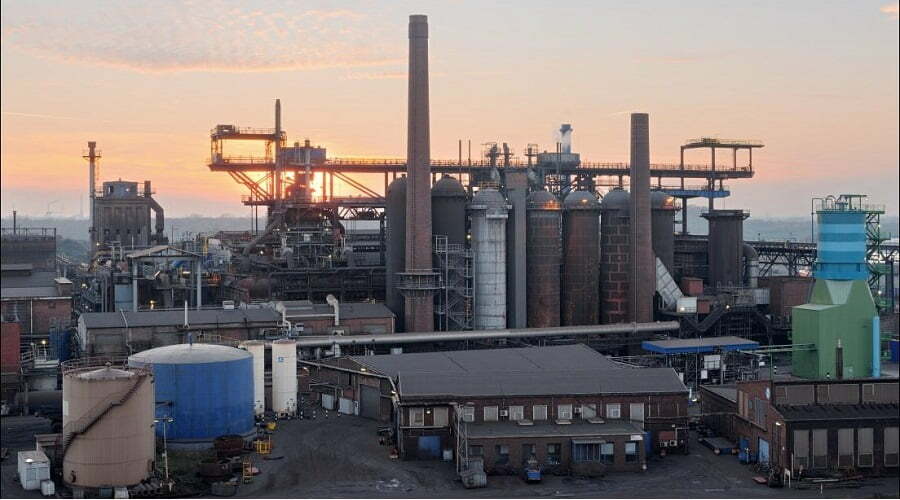Blast furnace ironmaking has been the main ironmaking process since 1709 when blast furnaces began making iron with coke instead of charcoal.
The blast furnace is a vertical continuous reactor. Raw materials, fuels, fluxes, etc. are added from the top of the furnace and run downward; the preheated air is blown in from the tuyere below, and conducts heat exchange and chemical reaction with the downward material column, which is a counter-flow operation, so the thermal efficiency and reaction efficiency are quite high.
Due to the mature technology of the blast furnace ironmaking process, reasonable energy consumption, good product quality, and stable production, blast furnace ironmaking accounts for more than 90% of the world’s total iron production.
The blast furnace ironmaking process is reduction smelting, and the thermodynamic principle of its metallurgical reaction has been fully understood. As the material column descends, it is gradually reduced from high-valent iron to low-valent iron to metal by carbon monoxide and hydrogen as Fe2O3⟶Fe3O4⟶FeO⟶Fe when it reaches 400℃.
This process of reducing iron from gaseous reducing agents carbon monoxide and hydrogen is called indirect reduction. The indirect reduction reaction is a reversible reaction. In order to make the reaction proceed in the direction of producing metallic iron, excess carbon monoxide or hydrogen must be present.
When the material column is lowered to the high-temperature region of 850-1000°C, the oxygen in the ore can be reduced by solid carbon, which is the direct reduction reaction. The direct reduction reaction is an irreversible reaction, but it is an endothermic reaction and requires more coke to be burned to compensate for the endothermic heat of the reaction.
Research and production experience shows that direct reduction and indirect reduction in a blast furnace are best carried out in a certain proportion. Generally speaking, direct reduction accounts for 20% to 30%, and indirect reduction accounts for 70% to 80%.
The blast furnace charge column is a moving bed with a very large height, and the uniform distribution of the updraft in it has a significant impact on the working environment and efficiency before operating an efficient blast furnace.
Therefore, the mechanical properties (strength, wear resistance, etc.) of various solid materials, especially coke, and the distribution of material layers during charging are particularly important for ironmaking operations. Powdered materials should not be charged into the blast furnace (less than 3% for particle size less than 5 mm).
The ore powder that has undergone beneficiation and enrichment treatment is made into artificial rich ore by agglomerating iron ore powder. Iron ore powder agglomeration mainly adopts a sintering or pelletizing process.
The advantage of sintering is that it can be made into sintered ore with high basicity, good reduction characteristics, and good mechanical properties. However, the gas generated by the sintering process contains sulfur dioxide, etc., which is a problem to be solved that damages the environment in iron and steel plants.
The raw materials of modern blast furnaces are mainly sintered ore, with a certain proportion of pellets. The coke used in the blast furnace is not only fuel and a reducing agent but also acts as a support for the material column to ensure gas permeability and smooth airflow in the furnace.
The resource of coking coal is the most scarce among all kinds of coal, and reducing the amount of coke is an important aspect of blast furnace technological progress. Blast furnace pulverized coal can replace part of the coke. Ideally, the amount of coke and pulverized coal should be 50/50.
Modern blast furnaces have reached a huge volume of 4,000 to 5,000 cubic meters. Large blast furnaces require large investments in equipment and construction funds, so blast furnaces must have a long life.
To this end, a series of technical measures should be taken, such as selecting a reasonable furnace type during design, selecting excellent refractory materials, creating a layer of slag skin on the surface of the cooling part for protection, and suppressing the high-temperature airflow at the edge of the furnace wall.
Generally, the first-generation blast furnace is about 15 years old, and the longevity blast furnace can be more than 20 years. In addition to blast furnace ironmaking, two ironmaking methods without coke have been developed: direct reduction ironmaking and smelting reduction ironmaking.
Direct reduction iron has a history of more than 100 years. It is reduced to a porous metal iron block called sponge iron (DRI) under conditions below the melting temperature. To prevent its re-oxidation, it can be hot-pressed into a block called hot briquetted iron (HBI).
The directly reduced iron has low carbon content and can be used as a high-quality raw material for electric arc furnace steelmaking to dilute the residual metals (copper, lead, arsenic, antimony, etc.) brought in by scrap steel.
After the middle of the 20th century, with the increase in the proportion of electric arc furnace steelmaking, the output of direct reduction ironmaking also increased significantly.
The goal of the smelting reduction ironmaking process is to replace coke with coal and directly use mineral powder to smelt molten iron, eliminating two processes that pollute the environment, coking, and sintering, in the iron and steel production process, so it is highly valued by the metallurgical community. However, due to technical difficulty, it has not been possible to completely use coke.

